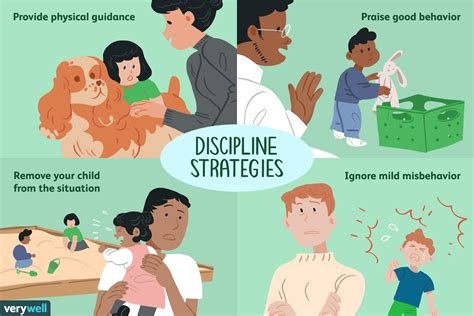The Role of Positive Discipline in Child Development: Strategies for Effective Discipline
Parenting can be a challenging journey, especially when it comes to discipline. It’s essential to understand the role of positive discipline in the development of our children. Positive discipline involves building a strong parent-child relationship, setting clear and consistent rules, and using positive reinforcement to encourage good behavior. By teaching problem-solving and conflict resolution skills and implementing age-appropriate consequences for misbehavior, we can promote self-regulation and emotional intelligence in our children. Additionally, encouraging open communication, active listening, and modeling positive behavior and attitudes are crucial for fostering a nurturing and supportive environment for our child’s growth. In this blog post, we will explore the strategies for effective positive discipline and its benefits in promoting the overall well-being and development of our children.
Understanding positive discipline and its benefits
Positive discipline is an approach to parenting that focuses on teaching children appropriate behavior rather than punishing them for their mistakes. This method encourages empathy, understanding, and mutual respect between parents and children. By establishing clear boundaries and expectations, parents can help their children develop a strong moral compass and a sense of responsibility.
One of the key benefits of positive discipline is that it fosters a healthy and open relationship between parents and children. Instead of using fear or intimidation to control their behavior, parents can communicate openly and honestly with their children. This creates an environment of trust and understanding, where children feel comfortable expressing their thoughts and feelings without fear of retribution.
Furthermore, positive discipline helps children develop critical thinking skills and self-control. By encouraging them to take responsibility for their actions and learn from their mistakes, parents can help their children become independent and resilient individuals. This approach also fosters a sense of empathy and compassion towards others, as children learn to consider the feelings and perspectives of those around them.
Overall, understanding and implementing positive discipline can lead to a harmonious and peaceful home environment, where children feel safe, valued, and respected. By nurturing a relationship built on trust and communication, parents can help their children develop the skills and qualities they need to become successful, empathetic, and well-adjusted adults.
Building a strong parent-child relationship
Building a strong parent-child relationship is essential for the overall well-being and development of a child. It lays the foundation for a healthy emotional and psychological growth, and helps in shaping the child’s behavior and attitudes. Parents play a crucial role in nurturing and fostering this relationship, and it requires time, effort, and commitment.
One of the key elements in building a strong parent-child relationship is spending quality time together. Engaging in activities that both the parent and child enjoy, such as playing games, reading books, or going for a walk, can strengthen the bond between them and create lasting memories.
Another important aspect is communication. Parents need to actively listen to their child’s thoughts, feelings, and concerns, and provide them with a safe space to express themselves. Open and honest communication fosters trust and understanding, and creates a supportive environment for the child.
Setting clear and consistent rules and expectations is also crucial in building a strong parent-child relationship. When children know what is expected of them and understand the consequences of their actions, it helps in establishing a sense of security and stability in the relationship.
Setting clear and consistent rules and expectations
Setting clear and consistent rules and expectations is crucial in creating a structured and harmonious environment for children. When children know what is expected of them, they are more likely to feel secure and confident in their actions. Consistency in enforcing these rules is equally important, as it helps children understand the consequences of their actions and learn accountability.
Parents can start by clearly defining the rules and expectations they have for their children. This can involve discussions with the children to ensure that the rules are understood and agreed upon. It’s important to make sure the rules are age-appropriate and realistic, taking into consideration the individual needs and capabilities of each child.
Consistency is key in maintaining these rules. Parents should be consistent in enforcing the rules and following through with consequences when necessary. When children see that the rules are consistently applied, they are more likely to internalize the expectations and act accordingly.
Ultimately, setting clear and consistent rules and expectations fosters a sense of structure and security in children, while also teaching them valuable lessons in accountability and responsibility.
Using positive reinforcement to encourage good behavior
Positive reinforcement is a powerful tool for parents and caregivers to encourage good behavior in children. By using positive reinforcement, we can help shape a child’s actions and attitudes in a way that promotes positive growth and development. This method involves rewarding desired behavior with praise, attention, or other privileges, which can help children understand the value of making good choices.
When parents consistently use positive reinforcement, it can strengthen the connection between behavior and consequences, making it more likely that the child will repeat the desired behavior. This approach can also help to build a child’s self-esteem and confidence, as they receive acknowledgment and recognition for their efforts.
It’s important to be specific and timely with positive reinforcement, focusing on the behavior you want to encourage and delivering praise or rewards promptly after the behavior occurs. This clarity helps the child understand exactly what they are being praised for, reinforcing the connection between the action and the positive outcome.
Overall, using positive reinforcement can be a valuable tool for parents and caregivers to promote a positive and nurturing environment, where children feel supported and encouraged to make good choices. By emphasizing and rewarding good behavior, we can help children develop the skills and attitudes that will serve them well as they grow and navigate the world around them.
Teaching problem-solving and conflict resolution skills
Teaching problem-solving and conflict resolution skills to children is an essential part of their emotional intelligence development. It helps them learn how to handle disagreements and solve problems in a constructive and peaceful manner. By teaching children these skills, parents and caregivers can help them navigate through challenging situations in a positive way.
One effective way to teach problem-solving and conflict resolution skills is to actively involve children in the process. Encouraging children to express their feelings and perspectives on a certain issue can help them understand different points of view and develop empathy. This can be done through open communication and active listening, where children feel heard and valued.
Another important aspect of teaching problem-solving and conflict resolution skills is modeling positive behavior and attitudes. Children often learn by observing the behavior of adults around them. When they see adults handling conflicts calmly and rationally, they are more likely to adopt similar approaches in their own interactions.
It’s also crucial to create a nurturing and supportive environment for growth, where children feel safe to express themselves and seek guidance when faced with conflicts. This environment can promote self-regulation and emotional intelligence, as children learn to manage their emotions and communicate effectively in challenging situations.
Implementing age-appropriate consequences for misbehavior
Implementing age-appropriate consequences for misbehavior is an important part of helping children learn how to make good choices and understand the impact of their actions. It involves using consequences that are suitable for the child’s age, developmental stage, and the specific misbehavior.
When implementing consequences, it’s crucial to remember that the goal is not to punish the child, but to teach them about responsibility and accountability. Consequences should be seen as learning opportunities rather than punishments. Consistency is also key when it comes to implementing age-appropriate consequences for misbehavior. Children need to know that there are predictable outcomes to their actions, whether positive or negative.
Using logical consequences is a helpful approach when dealing with misbehavior. These consequences are related to the misbehavior and require the child to take responsibility for their actions. For example, if a child is consistently forgetful with their homework, a logical consequence might be that they have to spend part of their free time catching up on missed assignments.
It’s also important to involve the child in the process of determining consequences. When children are able to have input in the consequences they face, they are more likely to understand and accept them. Additionally, it fosters a sense of ownership and responsibility for their actions.
Promoting self-regulation and emotional intelligence
Self-regulation and emotional intelligence are essential skills for children to develop as they grow. Promoting these skills in children can help them manage their emotions, make responsible decisions, and build healthy relationships with others. Self-regulation involves the ability to control one’s emotions, behavior, and impulses in different situations. It is a skill that can be taught and nurtured, and it is crucial for children’s overall wellbeing and success. Emotional intelligence is the ability to recognize, understand, and manage one’s own emotions, as well as to empathize with others and handle interpersonal relationships effectively.
Promoting self-regulation and emotional intelligence in children starts with creating a supportive and nurturing environment. Children need to feel safe and secure in their environment to develop the confidence and resilience needed for self-regulation and emotional intelligence. Building a strong parent-child relationship based on trust, empathy, and open communication is essential for promoting these skills. Parents and caregivers can model positive behavior and attitudes, such as patience, empathy, and problem-solving, to teach children how to regulate their emotions and respond to others’ emotions effectively.
Teaching problem-solving and conflict resolution skills is another important aspect of promoting self-regulation and emotional intelligence. Children need to learn how to manage conflict, handle disappointments, and solve problems on their own. By providing opportunities for children to practice these skills in a supportive and guidance-rich environment, parents and caregivers can help them develop the skills necessary for self-regulation and emotional intelligence.
It’s important to remember that promoting self-regulation and emotional intelligence is a process that takes time and patience. Consistency, positive reinforcement, and clear and age-appropriate expectations are key factors in helping children develop these essential skills. By implementing strategies to promote self-regulation and emotional intelligence, parents and caregivers can support children in becoming confident, empathetic, and socially adept individuals.
Encouraging open communication and active listening
Encouraging open communication and active listening is crucial in building strong and healthy relationships with our children. When we create an environment where our children feel comfortable expressing themselves, we are fostering a sense of trust and understanding. This allows them to develop the skills to communicate effectively and navigate their emotions. By actively listening to our children, we show them that their thoughts and feelings are valued, which in turn encourages them to be more open and honest with us. It’s important to set aside dedicated time to have meaningful conversations with our children, without any distractions.
One way to encourage open communication is by asking open-ended questions that prompt our children to share their thoughts and feelings. By showing genuine interest in what they have to say, we create a safe space for them to express themselves. It’s also important to validate their emotions and let them know that it’s okay to feel the way they do. This helps them to develop a healthy emotional intelligence and the ability to communicate their needs effectively.
Active listening goes hand in hand with open communication. When we practice active listening, we give our full attention to our children and show empathy towards their experiences. This means avoiding distractions, maintaining eye contact, and providing nonverbal cues that show we are engaged and understanding. By actively listening, we not only validate our children’s feelings, but we also demonstrate the importance of respectful communication.
Overall, by encouraging open communication and active listening, we lay the foundation for a strong parent-child relationship built on trust, understanding, and effective communication. This not only benefits our children in their development but also strengthens the bond we share with them.
Modeling positive behavior and attitudes
Modeling positive behavior and attitudes is essential in shaping the behavior of children. Children learn by observing the actions and words of the adults around them, so it is important for parents to demonstrate the behavior they want to see in their children.
When parents consistently exhibit positive behavior such as kindness, empathy, and respect, children are more likely to internalize these values and display them in their own interactions with others. This can have a profound impact on a child’s social and emotional development, as well as their overall well-being.
Additionally, modeling positive attitudes such as optimism, resilience, and a growth mindset can help children develop a healthy outlook on life. When children see their parents approaching challenges with a positive attitude and embracing opportunities for learning and growth, they are more likely to adopt a similar mindset.
Ultimately, parents serve as powerful role models for their children, and the way they behave and interact with others can greatly influence the values and attitudes their children internalize. By consciously modeling positive behavior and attitudes, parents can help create a nurturing environment that supports their children’s growth and development.
Creating a nurturing and supportive environment for growth
Creating a nurturing and supportive environment for growth is essential for the development and well-being of children. It involves providing a safe and loving space where children feel valued, supported, and encouraged to explore and learn. This type of environment fosters a sense of security and confidence in children, which is crucial for their overall growth and development.
When creating a nurturing and supportive environment, it’s important to pay attention to the physical surroundings as well as the emotional atmosphere. A well-organized and inviting space can promote a sense of calm and comfort, while positive interactions and connections with caregivers, teachers, and peers can contribute to a child’s emotional well-being.
Establishing routines and rituals can also contribute to a nurturing environment, as they provide a sense of predictability and stability for children. Consistent routines and rituals can help children feel secure and create a sense of trust in their environment and the people around them.
Ultimately, creating a nurturing and supportive environment for growth involves recognizing and meeting the emotional, physical, and social needs of children. By providing a space where children feel safe, loved, and supported, we can help them develop the skills and confidence they need to thrive and reach their full potential.
Frequently Asked Questions
What is positive discipline and how does it benefit child development?
Positive discipline focuses on teaching children appropriate behavior rather than punishing them for misbehavior. It helps children develop self-control, responsibility, and problem-solving skills, and promotes a strong parent-child relationship.
How can parents build a strong parent-child relationship through positive discipline?
Building a strong parent-child relationship involves fostering trust, open communication, and empathy. Parents can do this by spending quality time with their children, showing affection, and actively listening to their thoughts and feelings.
Why is it important to set clear and consistent rules and expectations for children?
Clear and consistent rules help children understand what is expected of them and provide a sense of structure and security. This can reduce confusion and conflict, and help children develop a sense of responsibility and self-discipline.
What are some strategies for using positive reinforcement to encourage good behavior in children?
Positive reinforcement involves praising and rewarding children for demonstrating desirable behaviors. This can include verbal praise, stickers, or special privileges, and can help children feel valued and motivated to continue their positive behavior.
How can parents effectively teach problem-solving and conflict resolution skills to their children?
Parents can teach problem-solving and conflict resolution skills by modeling good behavior, discussing and brainstorming solutions to problems, and encouraging children to express their feelings and listen to others’ perspectives. This can help children develop empathy, cooperation, and effective communication skills.
What are some age-appropriate consequences for misbehavior, and how can parents implement them effectively?
Age-appropriate consequences for misbehavior should be logical, related to the misbehavior, and manageable for the child. This can include time-outs, loss of privileges, or making amends. Consistency and follow-through are important for implementing consequences effectively.
How can parents promote self-regulation and emotional intelligence in their children through positive discipline?
Promoting self-regulation and emotional intelligence involves helping children recognize and manage their emotions, develop impulse control, and make responsible choices. Parents can do this by providing guidance, validation, and opportunities for practice.
What are some strategies for encouraging open communication and active listening between parents and children?
Encouraging open communication and active listening involves creating a safe and non-judgmental environment for children to express themselves, asking open-ended questions, and showing empathy and understanding. This can help strengthen the parent-child relationship and build trust.
How can parents model positive behavior and attitudes for their children?
Parents can model positive behavior and attitudes by demonstrating respect, kindness, patience, and problem-solving skills in their own actions and interactions. Children learn a great deal from observing and imitating their parents’ behavior.
What are some ways parents can create a nurturing and supportive environment for their children’s growth and development?
Creating a nurturing and supportive environment involves providing love and encouragement, setting realistic expectations, and offering guidance and support. This can help children feel secure, valued, and capable of achieving their full potential.






